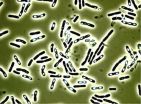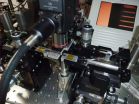(Press-News.org) A small area in the midbrain known as the substantia nigra is the control center for all bodily movement. Increasing loss of dopamine-generating neurons in this part of the brain therefore leads to the main symptoms of Parkinson's disease - slowness of movement, rigidity and shaking.
In recent years, there has been increasing scientific evidence suggesting that inflammatory changes in the brain play a major role in Parkinson's. So far, it has been largely unclear whether this inflammation arises inside the brain itself or whether cells of the innate immune system that enter the brain from the bloodstream are also involved.
At the DKFZ, a team led by Prof. Dr. Ana Martin-Villalba is investigating causes of cell death in the central nervous system. Neuroscientist Martin-Villalba has suspected that a specific pair of molecules, the CD95 system, is involved in neuronal death in Parkinson's. This pair consists of the CD95 ligand and its corresponding receptor, CD95, also known as the "death receptor".
Martin-Villalba recently showed that after spinal cord injury, inflammatory cells use these molecules to migrate to the injury site, where they cause damage to the tissue. Martin-Villalba then wanted to investigate whether peripheral inflammatory cells also play a role in chronic neurodegenerative processes such as Parkinson's disease.
To investigate the process of neurodegeneration in mice, the scientists utilized a model system using the substance MPTP, which causes the selective death of dopamine-generating neurons in the human brain. In mice, MPTP typically causes Parkinson-like symptoms.
However, in mice whose inflammatory cells (monocytes, microglia) were unable to produce CD95L, MPTP treatment resulted in almost no neurodegeneration. This suggested that CD95L-bearing inflammatory cells are involved in the destruction of neurons. However, it remained unclear whether the true culprits are specific macrophages in the brain called microglia, or rather monocytes in the bloodstream that infiltrate the brain.
In order to make this distinction, the investigators used a chemical that blocks CD95L without being able to pass the blood-brain barrier. This substance therefore reaches only the inflammatory cells that circulate in the bloodstream and not the microglia that reside in the brain. Mice that had received this substance were also protected from MPTP-induced neurodegeneration.
"Thus, we have shown for the first time that peripheral inflammatory cells of the innate immune system also play a role in neurodegeneration," say Liang Gao and David Brenner, first authors of the publication. "A key role in this process is played by CD95L, which enhances the mobility of these cells."
Project leader Martin-Villalba speculates that a self-reinforcing vicious cycle arises in the brain: The breakdown of a few neurons that die from various causes attracts inflammatory cells that, in turn, further fuel the death of more neurons through inflammation-promoting signaling molecules.
At present, the researchers can only indirectly conclude that the results obtained in the artificial animal model are also relevant in human Parkinson's disease. In collaboration with colleagues from Ulm, Martin-Villalba's team recently found elevated quantities of inflammatory monocytes that were hyperactive in blood samples from Parkinson's patients. Monocyte number correlated with the severity of disease symptoms. However, the researchers do not yet know whether these inflammatory cells also migrate into the brains of patients and contribute to the demise of neurons there, like they do in the mice with Parkinson's.
"If this is the case, drugs that inhibit CD95L might mitigate Parkinson's symptoms if administered early on - similar to what we observed in our experimental mice," says Martin-Villalba. The substance required for this has already been investigated in clinical Phase II trials. Martin-Villalba also suspects that activated cells of the peripheral immune system might drive neurodegeneration not only in Parkinson's disease but also in other neurodegenerative disorders such as Alzheimer's.
INFORMATION:
Gao L., D. Brenner, E. Llorens-Bobadilla, G. Castro-Saiz , T. Frank, P. Wieghofer, O. Hill, M. Thiemann, S. Karray, M. Prinz, J. Weishaupt, and A. Martin-Villalba. Infiltration of circulating myeloid cells through CD95L contributes to neurodegeneration in mice. Journal of Experimental Medicine 2015, DOI: 10.1084/jem.20132423.
Grozdanov, V., C. Bliederhaeuser, W.P. Ruf, V. Roth, K. Fundel-Clemens, L. Zondler, D. Brenner, A. Martin-Villalba, B. Hengerer, J. Kassubek, A.C. Ludolph, J.H. Weishaupt, and K.M. Danzer: Inflammatory dysregulation of blood monocytes in Parkinson's disease patients. Acta Neuropathol. 2014, DOI:10.1007/s00401-014-1345-4.
The German Cancer Research Center (Deutsches Krebsforschungszentrum, DKFZ) with its more than 3,000 employees is the largest biomedical research institute in Germany. At DKFZ, more than 1,000 scientists investigate how cancer develops, identify cancer risk factors and endeavor to find new strategies to prevent people from getting cancer. They develop novel approaches to make tumor diagnosis more precise and treatment of cancer patients more successful. The staff of the Cancer Information Service (KID) offers information about the widespread disease of cancer for patients, their families, and the general public. Jointly with Heidelberg University Hospital, DKFZ has established the National Center for Tumor Diseases (NCT) Heidelberg, where promising approaches from cancer research are translated into the clinic. In the German Consortium for Translational Cancer Research (DKTK), one of six German Centers for Health Research, DKFZ maintains translational centers at seven university partnering sites. Combining excellent university hospitals with high-profile research at a Helmholtz Center is an important contribution to improving the chances of cancer patients. DKFZ is a member of the Helmholtz Association of National Research Centers, with ninety percent of its funding coming from the German Federal Ministry of Education and Research and the remaining ten percent from the State of Baden-Württemberg.
Large amount of fat in neck muscles predicts chronic pain, disability and PTSD
Will enable earlier treatment for whiplash victims
Fat indicates atrophy, shows the chronic pain is not psychological
Whiplash affects more than 4 million Americans annually
CHICAGO --- While most people should expect to fully recover from whiplash injuries within the first few months, about 25 percent have long-term pain and disability that lasts many months or years.
Using special MRI imaging, Northwestern Medicine scientists have identified, within the first one and two weeks ...
EAST LANSING, Mich. --- America's welfare state is quietly evolving from needs-based to an employment-based safety net that rewards working families and fuels dreams of a better life, indicates a new study led by a Michigan State University scholar.
The major reason: the little-known Earned Income Tax Credit, a $65 billion federal tax-relief program for poor, working families. The program has been expanded dramatically during the past 25 years, while cash welfare has been sharply curtailed.
Reporting in the April issue of the American Sociological Review, Jennifer Sykes ...
ENVIRONMENT - Invertebrates' role in bioaccumulation ...
By studying fish and invertebrates in a creek with known mercury contamination, researchers are gaining a better understanding of the relationship between the toxin in the stream and bioaccumulation in organisms. While mercury concentrations in East Fork Poplar Creek in Oak Ridge, Tenn., have decreased significantly over the last 30 years, levels in tissue from fish have remained the same or increased. To understand why, a team led by Monica Poteat of Oak Ridge National Laboratory is examining the intricacies of ...
WASHINGTON, DC, April 1, 2015 -- America's welfare state is quietly evolving from needs-based to an employment-based safety net that rewards working families and fuels dreams of a better life, indicates a new study led by a Michigan State University (MSU) scholar.
The major reason: the little-known Earned Income Tax Credit (EITC), a $65 billion federal tax-relief program for poor, working families. The program has been expanded dramatically during the past 25 years, while cash welfare has been sharply curtailed.
Reporting in the April issue of the American Sociological ...
WASHINGTON, March 30, 2015 -- Last year, Reactions shook up the comedy world with a video featuring nothing but chemistry jokes. After overwhelming public acclaim, we're back for this April Fools' Day with round two, featuring a number of fan submissions. If you're looking for a laugh, or maybe a groan or two, check out the video here: https://youtu.be/QbxBsD_tDQw.
Subscribe to the series at http://bit.ly/ACSReactions, and follow us on Twitter @ACSreactions to be the first to see our latest videos.
INFORMATION:
The American Chemical Society is a nonprofit organization ...
Irvine, Calif., April 1, 2015 -- A pouchlike structure inside the heart's left atrial chamber in some people may explain strokes that otherwise lack an identifiable cause, according to UC Irvine School of Medicine researchers.
Dr. Mark Fisher, a professor of neurology and pathology & laboratory medicine, and colleagues evaluated 75 stroke patients at UC Irvine Medical Center to learn whether this left atrial septal pouch could be a potent source of stroke-causing blood clots.
Of the 23 patients who had experienced a stroke of undetermined origin (a "cryptogenic" stroke), ...
Jena (Germany) The "Villa trans lacum" at the eastern shore of the Laacher See (lake) in the volcanic part of the Eifel - a rural landscape in Germany - was a highly dangerous place. In the 19th century the Jesuit order bought the abbey Maria Laach and built a villa at the shore of the lake. This is where the friars congregated to pray far away from everyday life. But numerous Jesuits paid with their lives for the religious beliefs in the villa. Between 1864 and 1888 17 of them died in the building - literally in their sleep.
"The monks possibly died of carbon dioxide ...
This news release is available in German.
The Bacillus cereus bacteria is one of the potential causes of food poisoning. Indeed, a recent study in Analytical and Bioanalytical Chemistry shows that this versatile pathogen produces 19 different variants of a poison that causes nausea and vomiting in human beings. This variety could explain why some cases are relatively benign and others can result in death.
Across Europe, the number of food poisoning cases caused by the Bacillus species is on the rise. While unpleasant, infections resulting from B. cereus are usually ...
Our opponents always seem to be one step ahead. Although pest controllers now have numerous chemical preparations available, allowing them to take action against unwanted insects, the species targeted are developing a resistance against the different active substances at a rapid pace. Often a single change in the organisms' genetic material is enough to do this. This means that scientists know more than 500 pests all over the world currently able to resist a total of 300 different insecticides. Many disease-transmitting mosquitoes defy any attempts to control them just ...
The core circuits of quantum teleportation, which generate and detect quantum entanglement, have been successfully integrated into a photonic chip by an international team of scientists from the universities of Bristol, Tokyo, Southampton and NTT Device Technology Laboratories. These results pave the way to developing ultra-high-speed quantum computers and strengthening the security of communication.
Qubits (quantum bits) are sensitive quantum versions of today's computer 0's and 1's (bits) and are the foundation of quantum computers. Photons are particles of light and ...





